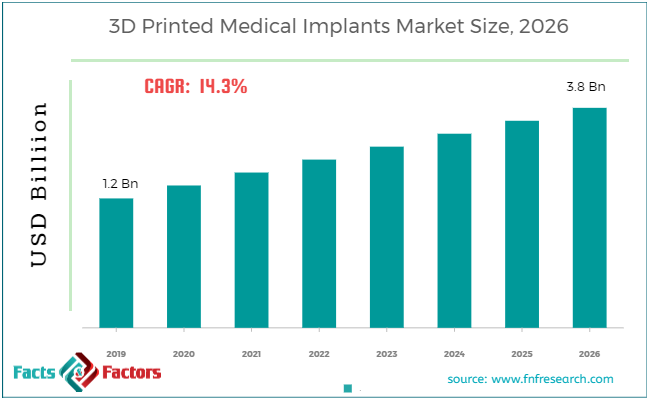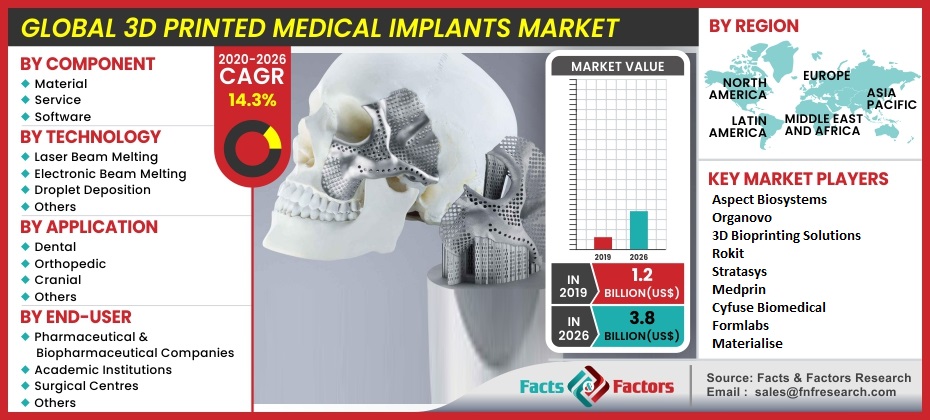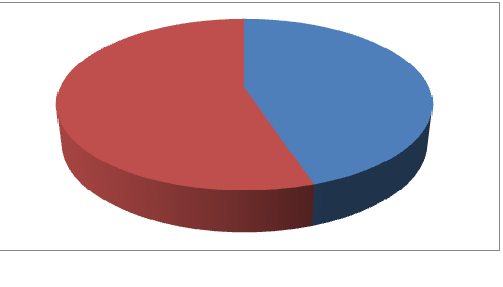Search Market Research Report
3D Printed Medical Implants Market Size, Share Global Analysis Report, 2020–2026

3D Printed Medical Implants Market By Component (Material, Service, and Software), By Technology (Laser Beam Melting, Electronic Beam Melting, Droplet Deposition, Others), By Application (Dental, Orthopedic, Cranial, Others), By End-User (Pharmaceutical & Biopharmaceutical Companies, Academic Institutions, Surgical Centers, Others) : Global Industry Outlook, Market Size, Business Intelligence, Consumer Preferences, Statistical Surveys, Comprehensive Analysis, Historical Developments, Current Trends, and Forecast 2020–2026
Industry Insights
[190+ Pages PDF Report] According to the report published by Facts & Factors, the global 3D printed medical implants market size was worth around USD 1.2 billion in 2019 and is predicted to grow around USD 3.8 billion by 2026 with a compound annual growth rate (CAGR) of roughly 14.3% between 2020 and 2026. The report analyzes the global 3D Printed Medical Implants market drivers, restraints/challenges, and the effect they have on the demands during the projection period. In addition, the report explores emerging opportunities in the 3D Printed Medical Implants market.
This specialized and expertise-oriented industry research report scrutinizes the technical and commercial business outlook of the 3D printed medical implants industry. The report analyzes and declares the historical and current trends analysis of the 3D printed medical implants industry and subsequently recommends the projected trends anticipated to be observed in the 3D printed medical implants market during the upcoming years.

The 3D printed medical implants market report analyzes and notifies the industry statistics at the global as well as regional and country levels in order to acquire a thorough perspective of the entire 3D printed medical implants market. The historical and past insights are provided for FY 2016 to FY 2019 whereas projected trends are delivered for FY 2020 to FY 2026. The quantitative and numerical data is represented in terms of value (USD Million) from FY 2016 – 2026.
The quantitative data is further underlined and reinforced by comprehensive qualitative data which comprises various across-the-board market dynamics. The rationales which directly or indirectly impact the 3D printed medical implants industry are exemplified through parameters such as growth drivers, restraints, challenges, and opportunities among other impacting factors.

Throughout our research report, we have encompassed all the proven models and tools of industry analysis and extensively illustrated all the key business strategies and business models adopted in the 3D printed medical implants industry. The report provides an all-inclusive and detailed competitive landscape prevalent in the 3D-printed medical implants market.
The report utilizes established industry analysis tools and models such as Porter’s Five Forces framework to analyze and recognize critical business strategies adopted by various stakeholders involved in the entire value chain of the 3D printed medical implants industry. The 3D printed medical implants market report additionally employs SWOT analysis and PESTLE analysis models for further in-depth analysis.
The report study further includes an in-depth analysis of industry players' market shares and provides an overview of leading players' market position in the 3D printed medical implants sector. Key strategic developments in the 3D printed medical implants market competitive landscape such as acquisitions & mergers, inaugurations of different products and services, partnerships & joint ventures, MoU agreements, VC & funding activities, R&D activities, and geographic expansion among other noteworthy activities by key players of the 3D printed medical implants market are appropriately highlighted in the report.
 Key Insights from Primary Research
Key Insights from Primary Research
- As per our primary respondents, the global 3D printed medical implants market is set to grow annually at a rate of around 14.3%, and the revenue was valued at around USD 1.2 Billion in 2019.
- North America held the largest market share in 2019 due to the awareness among the population regarding the newest technologies and advancements in the region.
- On the basis of the “component” segment, the software segment dominated the global 3D printed medical implants market owing to a rise in investments in the development of software solutions.
- Based on “end-user”, the global 3D printed medical implants market was led by the surgical center's segment due to the minimized complications by the use of 3D printed medical devices.
- The presence of well-established players has intensified the industry rivalry, due to which the degree of competition is considerably higher.
 Key Recommendations from Analysts
Key Recommendations from Analysts
- As per our analysts, the global 3D-printed medical implants market is expected to grow significantly over the forecast period.
- As per analysts, the high growth in technological advancements in the field of healthcare is boosting the market.
- The collaborations and partnerships between manufacturing firms can create lucrative opportunities worldwide.
- Our team of analysts has identified, that North America is expected to be the fastest-growing market over the estimated period, due to the newest technologies and advancements in the region.
 Global 3D Printed Medical Implants Market Revenue Share – By Component
Global 3D Printed Medical Implants Market Revenue Share – By Component

The global 3D-printed medical implants market is experiencing significant growth that is expected to continue over the upcoming years. Also, the high growth in technological advancements in the field of healthcare will boost the demand for the 3D-printed medical implants market in the coming years.
Moreover, the collaborations and partnerships between the manufacturing firms to enhance the development of products has affected the market growth. Chronic diseases are also increasing day by day which includes a rise in accidents; bone dental diseases will definitely propel the growth of the 3D printed medical implants market.
The 3D printed medical implants market research report delivers an acute valuation and taxonomy of the 3D printed medical implants industry by practically splitting the market on the basis of different components, technology, applications, end-users, and regions. Through the analysis of the historical and projected trends, all the segments and sub-segments were evaluated through the bottom-up approach, and different market sizes have been projected for FY 2020 to FY 2026.
The regional segmentation of the 3D printed medical implants industry includes the complete classification of all the major continents including North America, Latin America, Europe, Asia Pacific, and the Middle East & Africa. Further, country-wise data for the 3D printed medical implants industry is provided for the leading economies of the world.
 Report Scope
Report Scope
Report Attribute |
Details |
Market Size in 2019 |
USD 1.2 Billion |
Projected Market Size in 2026 |
USD 3.8 Billion |
CAGR Growth Rate |
14.3% CAGR |
Base Year |
2019 |
Forecast Years |
2020-2026 |
Key Market Players |
Aspect Biosystems, Organovo, 3D Bioprinting Solutions, Rokit, Stratasys, Medprin, Cyfuse Biomedical, Formlabs, Materialise, BioBots, among others. |
Key Segment |
By Component, Technology, Application, End-User, and Region |
Major Regions Covered |
North America, Europe, Asia Pacific, Latin America, and the Middle East &, Africa |
Purchase Options |
Request customized purchase options to meet your research needs. Explore purchase options |
The 3D printed medical implants market is segmented based on component, technology, application, end-user, and region. On the basis of component segmentation, the market is classified into Material, Service, and Software. In terms of technology segmentation, the market is bifurcated into Laser Beam Melting, Electronic Beam Melting, Droplet Deposition, and Others. In terms of application, the market is classified into Dental, Orthopedic, Cranial, and Others. Lastly, on the basis of end-user, the market is bifurcated into Pharmaceutical & Biopharmaceutical Companies, Academic Institutions, Surgical Centers, and Others.
 Major key players operating in the 3D-printed medical implants market include:
Major key players operating in the 3D-printed medical implants market include:
- Aspect Biosystems
- Organovo
- 3D Bioprinting Solutions
- Rokit
- Stratasys
- Medprin
- Cyfuse Biomedical
- Formlabs
- Materialise
- BioBots
The taxonomy of the 3D printed medical implants market industry by its scope and segmentation is as follows:
 By Component Analysis
By Component Analysis
- Material
- Service
- Software
 By Technology Analysis
By Technology Analysis
- Laser Beam Melting
- Electronic Beam Melting
- Droplet Deposition
- Others
 By Application Analysis
By Application Analysis
- Dental
- Orthopedic
- Cranial
- Others
 By End-User Analysis
By End-User Analysis
- Pharmaceutical & Biopharmaceutical Companies
- Academic Institutions
- Surgical Centres
- Others
 By Regional Segmentation Analysis
By Regional Segmentation Analysis
- North America
- The U.S.
- Canada
- Europe
- Germany
- The UK
- France
- Spain
- Italy
- Rest of Europe
- Asia Pacific
- China
- Japan
- India
- South Korea
- Southeast Asia
- Rest of Asia Pacific
- Latin America
- Brazil
- Mexico
- Rest of Latin America
- Middle East & Africa
- GCC
- South Africa
- Rest of the Middle East & Africa
Industry Major Market Players
- Aspect Biosystems
- Organovo
- 3D Bioprinting Solutions
- Rokit
- Stratasys
- Medprin
- Cyfuse Biomedical
- Formlabs
- Materialise
- BioBots
Frequently Asked Questions

Copyright © 2024 - 2025, All Rights Reserved, Facts and Factors


